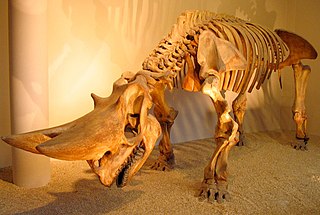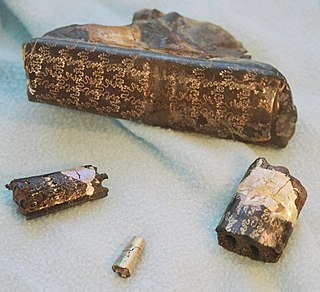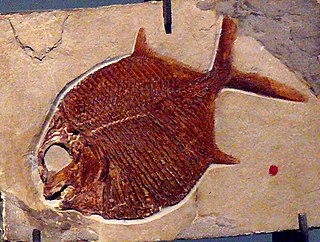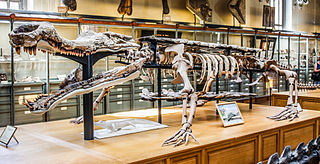 W
WAraripesuchus is a genus of extinct crocodyliform that existed during the Cretaceous period of the late Mesozoic era some 125 to 66 million years ago. Six species of Araripesuchus are currently known. They are generally considered to be notosuchians, characterized by their varied teeth types and distinct skull elements. This genus consists of other five related species: A. wegeneri and A. rattoides, discovered in Niger, A. tsangatsangana, discovered in Madagascar, A. gomesii, discovered in Brazil and another species discovered in Argentina, A. patagonicus.
 W
WArsinoitherium is an extinct genus of paenungulate mammals belonging to the extinct order Embrithopoda. It is related to elephants, sirenians, hyraxes and the extinct desmostylians. Arsinoitheres were superficially rhinoceros-like herbivores that lived during the late Eocene and the early Oligocene of northern Africa from 36 to 30 million years ago, in areas of tropical rainforest and at the margin of mangrove swamps. A species described in 2004, A. giganteum, lived in Ethiopia about 27 million years ago.
 W
WBaculites is an extinct genus of cephalopods with a nearly straight shell, included in the heteromorph ammonites. The genus, which lived worldwide throughout most of the Late Cretaceous, was named by Lamarck in 1799.
 W
WComposita is an extinct brachiopod genus that lived from the Late Devonian to the Late Permian. Composita had a cosmopolitan global distribution, having lived on every continent except Antarctica. Composita had a smooth shell with a more or less distinct fold and sulcus and a round opening for the pedicle on the pedicle valve. Composita is included in the family Athyrididae and placed in the subfamily Spirigerellinae.
 W
WGyrodus is an extinct genus of pycnodontiform ray-finned fish that lived from the late Triassic (Rhaetian) to the middle Cretaceous (Cenomanian).
 W
WMawsonia is an extinct genus of prehistoric coelacanth fish, and the largest of this group, ranging from an estimated 3.5 metres up to 6.3 metres long. It lived during the Cretaceous period. Fossils have been found in the Bahia Group, Romualdo, Alcântara and Missão Velha Formations of Brazil, South America, as well as the Continental Intercalaire of Algeria and Tunisia, the Ain el Guettar Formation of Tunisia, and the Babouri Figuil Basin of Cameroon, Africa. Mawsonia was first described by British palaeontology Arthur Smith Woodward in 1907. The type species is Mawsonia gigas, named and described in 1907. Numerous distinct species have been described since then. M. brasiliensis, M. libyca, M. minor, and M. ubangiensis have all been proposed to be synonyms of M. gigas, although Léo Fragoso's 2014 thesis on mawsoniids finds M. brasiliensis valid and cautions against synonymizing M. minor without further examination. Several recent publications consider M. brasiliensis to be valid as well. Although initially considered to belong to this genus, "Mawsonia" lavocati is most likely referable to Axelrodichthys instead.
 W
WPlanolites is an ichnogenus found throughout the Phanerozoic that is made during the feeding process of worm-like animals. The traces are generally small, 1–5 mm (0.039–0.197 in), unlined, and rarely branched, with fill that differs from the host rock.
 W
WSarcosuchus is an extinct genus of crocodyliform and distant relative of living crocodylians that lived during the Early Cretaceous, from the late Hauterivian to the early Albian, 133 to 112 million years ago of what is now Africa and South America. It was one of the largest crocodile-line reptiles, reaching an average estimate of 9 m (30 ft) and 3.5 metric tons, but estimated to grow up to 9.5 m (31 ft) in body length and weigh up to 4.3 metric tons. It is known from two species, S. imperator from the early Albian Elrhaz Formation of Niger and S. hartti from the Late Hauterivian of northeastern Brazil, other material is known from Morocco and Tunisia and possibly Libya and Mali.
 W
WSpinosaurus is a genus of spinosaurid dinosaur that lived in what now is North Africa during the Cenomanian to upper Turonian stages of the Late Cretaceous period, about 99 to 93.5 million years ago. This genus was known first from Egyptian remains discovered in 1912 and described by German paleontologist Ernst Stromer in 1915. The original remains were destroyed in World War II, but additional material has come to light in the early 21st century. It is unclear whether one or two species are represented in the fossils reported in the scientific literature. The best known species is S. aegyptiacus from Egypt, although a potential second species, S. maroccanus, has been recovered from Morocco. The contemporary spinosaurid genus Sigilmassasaurus has also been synonymized by some authors with S. aegyptiacus, though other researchers propose it to be a distinct taxon. Another possible junior synonym is Oxalaia from the Alcântara Formation in Brazil.
 W
WSteneosaurus is a dubious genus of teleosaurid crocodyliform from the Middle or Late Jurassic of France. The genus has been used as a wastebasket taxon for thalattosuchian fossils for over two centuries, and almost all known historical species of teleosauroid have been included within it at one point. The genus has remained a wastebasket, with numerous species still included under the label ‘Steneosaurus’, many of which are unrelated to each other.